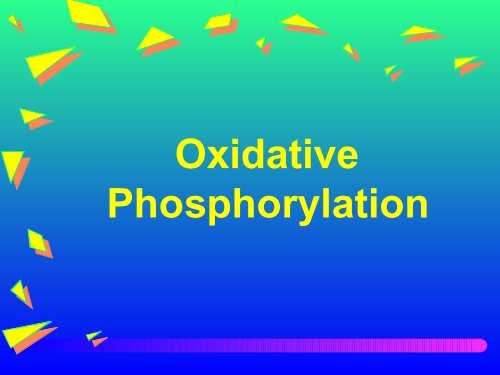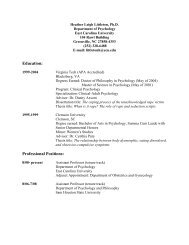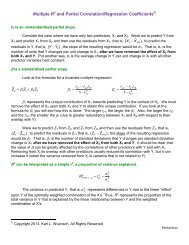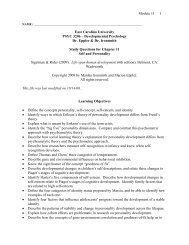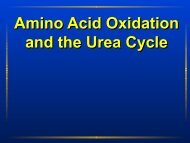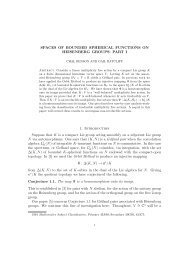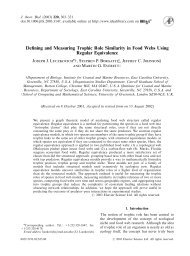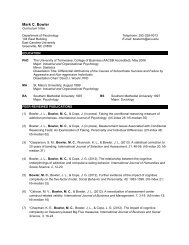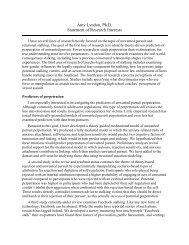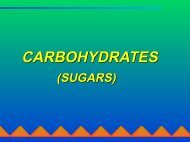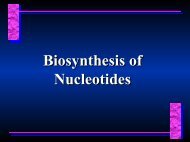Oxidative Phosphorylation - Ecu
Oxidative Phosphorylation - Ecu
Oxidative Phosphorylation - Ecu
- No tags were found...
Create successful ePaper yourself
Turn your PDF publications into a flip-book with our unique Google optimized e-Paper software.
<strong>Oxidative</strong><strong>Phosphorylation</strong>
• NADH from Glycolysis must be transportedinto the mitochondrion to be oxidized by therespiratory electron transport chain.• Only the electrons from NADH aretransported, these are used to form eitherNADH or FADH 2.• This is accomplished by one of two shuttlemechanisms.
Glycerophosphate Shuttle(skeletal muscle, brain)NADH, H +3-PhosphoglycerolDehydrogenaseNAD +CytosolH 2C - OHC = OCH 2OPO 32-DHAPH 2C - OHHO - C - HCH 2OPO 32-3-PhosphoglycerolETCe -FADH 2FlavoproteinD’haseFADInnermitochondrialmembrane
Malate-Aspartate Shuttle(Liver, Kidney, Heart)MalateNAD+Malate D’haseNADHOAAAspartateAminotransferaseAspartatea-KgGlutamateCytosolMalate:α-KgcarrierInnerMito.MembraneGlutamate:Aspartatecarriera-KgGlutamateMalateNAD+Malate D’haseNADHOAAAspartateAminotransferaseMatrixAspartate
• <strong>Oxidative</strong> <strong>Phosphorylation</strong>: NADH and QH 2are oxidizedby the respiratory electron transport chain (ETC).• ETC is set of membrane-embedded protein complexesthat act as electron carriers, passing electrons fromNADH and QH 2to molecular oxygen.• As electrons move through the complexes, protons aretransported across the inner mito. membrane from thematrix to the intermembrane space.• The energy stored in this ion gradient is used tosynthesize ATP from ADP and Pi by a membranebound ATPase.Chemiosmotic Theory : Formulated by PeterMitchell in the 1960’s. Nobel Prize for this workawarded in 1978.
Succinate2e -FADH 2NADH2e -Complex INAD + (-0.315V)∆Ε o’ = 0.360V; (∆G o’ = -69.5 kJ/mol)Complex IICoQ (+0.45V)ADP + PiRotenone;AmytalATPDemerolFumarateComplex III∆Ε o’ = 0.190V; (∆G o’ = -36.7 kJ/mol)Cytochrome C (+0.235V)Complex IV∆Ε o’ = 0.580V; (∆G o’ = -112 kJ/mol)2e2H + + 1/2 O -2 H 2 0 (+0.815 V)ADP + PiAntimycin AATPADP + PiCN - ; COATP
Meaning of the standard reduction potential:When compound loses an e- (serves as a reductant),the structure left behind becomes capable of acceptingan e- (serves as an oxidant).cytochrome b(Fe++)+cytochrome c(Fe+++)cytochrome b(Fe+++)+cytochrome c(Fe++)Reductant XOxidant YOxidant X’ Reductant Y’Reductant X and Oxidant X’ are termed a REDOX PAIR!Electrons flow from the redox pair with the morenegative E 0 to the more positive E 0 .
The Reduction of Q is a 2 ElectronReduction !1. Q + 1e - Q .-2. Q .- + 1e - + 2H + QH 2
Electron Transport Through Complex I(NADH Dehydrogenase)2H +intermembranespaceFMN FMNH 2NADH NAD +transfersH + 2 one e -FeS2 one e-transfers2H +matrixQH 2Q
Electron Transport Through Complex II(Succinate Dehydrogenase)intermembranespaceFAD2e -2 one e -transfersFeSb 5602 one e-transfersQH 2QSuccinateFumarate2H +matrix
Complex III (Cytochrome bc Complex)1 Q cycle - first step:2H +intermembrane spaceQQeQ -. eFe-S -cyt. ce -1b QH5662e -b 562e -Q .matrix
Complex III (Cytochrome bc Complex)1 Q cycle - second step:2H +intermembrane spaceQeQ -. eFe-S -cyt. ce - 1b QH5662e -b 562Q .e -QH 22H +matrix
Complete Q Cycle:intermembranespace2 x 2H +cyt. c2QQ2 x 1e -Q .e -2Fe-S cyt. ce - 12b QH5662e -b 562Q .2 x 12 x 12 x 1e - e -QH 22H +matrix
Electron Transport Through Complex IV(Cytochrome Oxidase)cyt. c2H +intermembranespace2 one e -transfersCu-aCyt. aCu-b 2 one e -Cyt. a3 transfersmatrix1/2 O 2 H 2 O2H + 2H +
Complex V (ATP Synthase; F F ATPase)o 1 A Rotating Molecular Motor• Consumes the energy in the proton gradientto synthesize ATP from ADP.• Couples the phosphorylation of ADP to theoxidation of substrates in the mitochondrion(hence oxidative phosphorylation).• Mechanism of ATP synthesis is now known, aswell as the x-ray crystal structure. Paul Boyerand John Walker won the Nobel Prize in 1997for this work.
• F1 contains the catalytic subunits; structureis α3,β3,γ3,δ,ε• Fo forms a channel in the membrane that allowsthe passage of protons; structure is a1;b2;c9-12• Fo is sensitive to oligomycin and DCCD (DCCDreacts with a single glutamate residue on the csubunit to block the channel.
Binding Change Mechanism (Boyer):• F1 has three interacting and conformationallydistinct active sites.• Protons bind to aspartate residues in the csubunit rotor and cause it to rotate.• This rotations causes the γ subunit to turnrelative to the three β subunit nucleotide sitesof F1, changing the conformation of each insequence, so that ADP is first bound, thenphosphorylated, then released.
Electron Transport Inhibitors:• Rotenone; Amytal and Demerol inhibitComplex I• Antimycin A inhibits Complex III• Cyanide; Azide; Carbon Monoxide inhibitComplex IV• Electron transport can still proceed in thepresence of inhibitors if an electron donor isadded that bypasses the site of inhibition.
Uncouplers:• Lipid-soluble weak acids that carry protonsfrom the intermembrane space back into thematrix• No ATP is produced, but electron transport canproceed.• Uncoupled electron transport generates HEAT.This can be useful to both plants and animals.• Thermogenin (a protein) is a naturaluncoupler found in brown adipose tissue.
The Alternative Oxidase (AO):• Occurs in plants; bypasses Complexes III andIV (less ATP made)QH 2AO2H+1/2 O 2 ; 2 e-H 2 O• Runs when [ATP] is high. Turned on bywounding; flowering; chemicals. May act asa protective mechanism to alleviate effects ofreactive oxygen species that form when thenormal chain is backed up
Control of Ox. Phos.:Control is tied to the cellular energy demand.This is sensed largely by [ATP].As ATP is consumed in the cytosol, ADP istransported into the matrix (in antiport withATP) by the adenine nucleotide translocase.Electron transport, strictly coupled to [ADP]accelerates.
Since ATP carries a charge of -4 and ADPcarries a charge of -3, transporting an ATPfrom the matrix to the cytosol results inaddition of one negative charge on thecytoplasmic side of the inner mitochondrialmembrane.This is equivalent to moving a proton backinto the matrix from the cytosol.It takes 3 protons moving through Fo toproduce 1 ATP. Taking into account movingthis ATP to the cytosol, we can conclude thatit takes a total of 4 protons/ATP synthesized.
How many protons are translocatedper 2 e- transferred?Complex I: 4H +Complex III: 4H +Complex IV: 2H +1 ATPX4 H + 10 H H++10H + : 2e -2e -(NADH 1/2 O 2 )
1 ATPX4 H + 10 H H++2e -(NADH 1/2 O 2 )1 ATPX4 H + 10 H H++ 10O 42.5PORatio !


